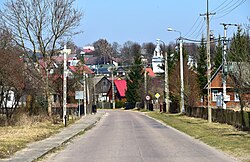Krynki
Krynki | |
|---|---|
Town | |
 View of the town, April 2018 | |
 Flag  Coat of arms | |
 Krynki | |
| Coordinates: 53°15′56″N 23°46′20″E / 53.26556°N 23.77222°ECoordinates: 53°15′56″N 23°46′20″E / 53.26556°N 23.77222°E | |
| Country | |
| Voivodeship | Podlaskie |
| County | Sokółka |
| Gmina | Krynki |
| Population (2016) | |
| • Total | 2,470 |
| Website | http://krynki.pl/ |

Krynki pronounced [ˈkrɨŋkʲi] (Belarusian: Крынкі, romanized: Krynki) is a town in northeastern Poland, located in Podlaskie Voivodeship along the border with Belarus. Krynki is famous for its history and its old buildings. It lies approximately 24 kilometres (15 mi) south-east of Sokółka and 45 km (28 mi) east of the regional capital Białystok.
History[]
Krynki received town privileges in 1569. Throughout history, it was an important textile, leather and pottery center. In 1914, the town's population was 10,000 people, about 80 percent of them Jewish. The remainder was made up of Christian Poles and ethnic Belarusians. Krynki used to be a multicultural town prior to World War II, and before the Holocaust in occupied Poland. Today, the majority of Krynki's citizens are Catholic, but there is a Belarusian minority still present.[1] Krynki lost city rights in 1950 in Stalinist Poland due to significant loss of population, but regained them in 2009.[2]
Jewish heritage[]
Jews began living in Krynki in the 17th century when the Polish king Władysław IV Vasa invited them to town to boost trade and manufacturing. From that moment, the Jewish population continued to grow and their culture flourished.[1]
A notable part of Krynki's history was the Jewish labour movement of 1905. In that year, Jakow Pat led Jewish workers and created the independent Republic of Krynki in defiance of the Russian imperial rule. After World War I Poland returned to independence and democracy. The Jews began emigrating to Palestine and the United States for greater economic benefit.[1]
The Holocaust[]
During World War II, Krynki was occupied by the Soviets from 1939 until 1941 and by Nazi Germany after Operation Barbarossa. The German authorities began the reign of terror by executing 30 prominent Jews, and in December 1941 created a Jewish ghetto in Krynki. The Jews from neighbouring settlements were deported to Krynki including 1,200 inhabitants of Brzostowica Wielka. Around 6,000 people were imprisoned there with insufficient food and severe overcrowding. The liquidation of the ghetto began in November 1942. The ghetto inmates, men, women and children, were deported to the Nazi transit camp in Kiełbasin and sent off aboard Holocaust trains to the Treblinka extermination camp.[1]
The Jewish population, however, did not remain passive. During the ghetto liquidation action, a number of Jewish insurgents responded by shooting at the Nazi police including their gun-wielding Belarusian auxiliaries, and many escaped into the forest.[3] Today, no Jews live in Krynki, but the memory of them still lives on.
Points of interest[]
- One of the largest, oldest Jewish cemeteries in eastern Poland.
- Two Orthodox churches and cemeteries.
- St. Anne's Catholic church, designed by Stefan Szyller who is famous for designing the Poniatowski Bridge in Warsaw.
- Krynki originally was home to three synagogues. Two are still standing, however they are not active. The crumbling ruins of the third and the largest Beth Ha Kneseth Synagogue destroyed by the Nazis were imploded in 1971 by the communist authorities for safety reasons.
References[]
- ^ Jump up to: a b c d "Krynki". History before 1989. Virtual Shtetl, POLIN Museum of the History of Polish Jews. 2015. Archived from the original on 17 November 2015. Retrieved 15 November 2015.
- ^ Ordinance of the Council of Ministers of the Republic of Poland Archived 2009-03-03 at the Wayback Machine (in Polish)
- ^ "Krynki Ghetto (resistance)". Virtual Shtetl, POLIN Museum of the History of Polish Jews. 2015. Source: Bernard Mark, Walka i zagłada warszawskiego getta, Wydawnictwo MON 1959, Also in: Ewa Kopeć & Alicja Miron, Holocaust kryńskich Żydów. OCLC 16794833. Archived from the original on 17 November 2015. Retrieved 15 November 2015.
The young Jewish former residents of Krynki who went on to write the Pinkas Krynki many years later in Israel remained unable to differentiate between the ethnic makeup of Schutzmannschaft formations due to the language barrier, and lumped the locals into one, in terms of nationality. Meanwhile, the role of the Belarusian Auxiliary Police in the killing the Jews became particularly noticeable starting at about that time, in February–March 1942. — Алексей Літвін, Участие местной полиции в уничтожении евреев, в акциях против партизан и местного населения (in) Местная вспомогательная полиция на территории Беларуси, июль 1941 — июль 1944 гг. (The auxiliary police in Belarus, July 1941 - July 1944).
External links[]
| Wikimedia Commons has media related to Krynki, Podlaskie Voivodeship. |
- Cities and towns in Podlaskie Voivodeship
- Grodnensky Uyezd
- Białystok Voivodeship (1919–1939)
- Belastok Region
- Shtetls
- Holocaust locations in Poland
